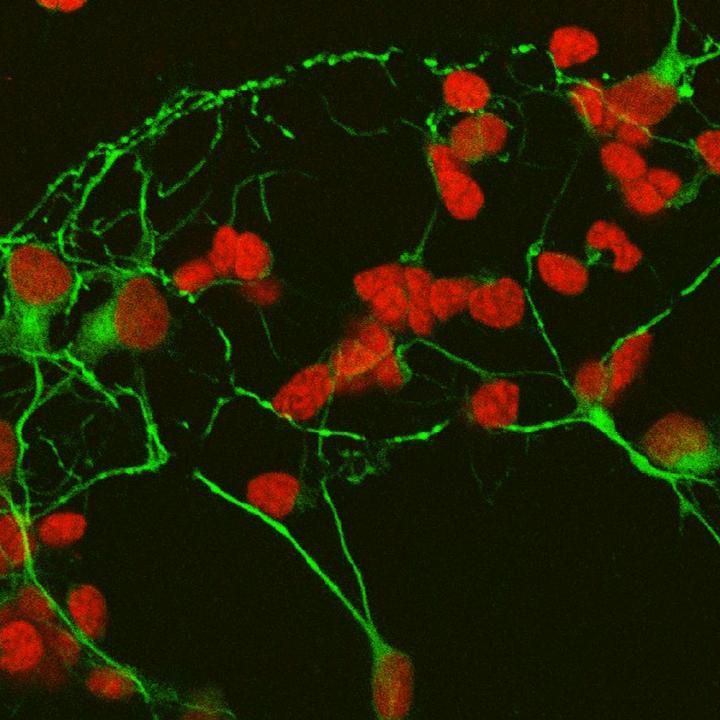NIH study breaks down pigment epithelium-derived factor to understand how it protects and stimulates retinal neurons
Researchers at the National Eye Institute (NEI) have determined how certain short protein fragments, called peptides, can protect neuronal cells found in the light-sensing retina layer at the back of the eye. The peptides might someday be used to treat degenerative retinal diseases, such as age-related macular degeneration (AMD). The study published today in the Journal of Neurochemistry. NEI is part of the National Institutes of Health.
A team led by Patricia Becerra, Ph.D., chief of the NEI Section on Protein Structure and Function, had previously derived these peptides from a protein called pigment epithelium-derived factor (PEDF), which is produced by retinal pigment epithelial cells that line the back of the eye.
“In the eye, PEDF protects neurons from dying. It prevents the invasion of blood vessels, it prevents inflammation, it has antioxidant properties–all these are beneficial properties,” said Becerra, the senior author of the study. Her studies suggest that PEDF is part of the eye’s natural mechanism for maintaining eye health. “PEDF may have a role for treating eye disease. If we want to exploit the protein for therapeutics, we need to separate out the regions responsible for its various properties and determine how each of them works.”
The team used a well-known cell culture model system where immature retinal cells are isolated from the eyes of newborn rats and grown in a dish with minimal nutrients. The system includes not only the retina’s light-sensing photoreceptors, but additional types of neurons that help the retina process and transmit visual information to the brain.
“Our model system – using cells isolated from the animal – lets us tease out the individual processes and mechanisms behind PEDF’s protective effects,” said Germán Michelis, graduate student and the study’s first author.
The PEDF protein has functionally distinct domains. The Becerra lab previously found that each domain can work independently. One area, which is called the 34-mer because it is formed by 34 amino acid building blocks, halts blood vessel growth. Aberrant blood vessel growth is central to retinal diseases such as AMD and diabetic retinopathy. The second PEDF domain, called the 44-mer, provides anti-death signals to retinal neurons. The 44-mer can also stimulate neurons to grow neurites, finger-like projections that help the neurons communicate with their neighbors. A shorter version of the 44-mer of only 17 amino acids (17-mer) has identical activities.
Michelis and colleagues tested whether the 44-mer could protect immature retinal cells in a dish. Without the presence of proteins and other cells in their usual retinal environment, immature photoreceptors quickly die but can be preserved with PEDF.
They found that both the 44-mer and 17-mer were as capable of saving these photoreceptors as full-length PEDF.
The researchers also found that PEDF activity appears to be most needed at a specific point in photoreceptor cell development. Light detection takes place in a part of the photoreceptor known as the outer segment, where light-sensing opsin proteins are concentrated. The scientists found that when a photoreceptor cell is just beginning to create its outer segments, PEDF triggers the movement of opsin into the budding outer segment, where it belongs.
Further, the 44-mer and 17-mer peptides work by binding to a protein receptor (PEDF-R) on the surface of neurons. PEDF activates PEDF-R, which processes molecules like docosahexaenoic acid (DHA), an omega-3 fatty acid critical for babies’ development and for eye health. PEDF-R was discovered previously by the Becerra lab.
“We’ve known for a long time that DHA is important for retinal health. We think PEDF signaling might be a key component of regulating omega-3 fatty acids like DHA, both during eye development and in maintaining the eye’s health over time,” said Becerra. “We’re hoping that we can harness some of these protective effects in a peptide-based therapeutic approach in the near future.”
###
This study was funded by the National Eye Institute Intramural Program and the National Research Council of Argentina.
Reference: Michelis G, German OL, Villasmil R, Soto T, Rotstein NP, Politi L, and Becerra SP. “Pigment Epithelium-derived Factor (PEDF) and Derived Peptides Promote Survival and Differentiation of Photoreceptors and Induce Neurite-outgrowth in Amacrine Neurons.” Journal of Neurochemistry. June 16, 2021. https:/
This press release describes a basic research finding. Basic research increases our understanding of human behavior and biology, which is foundational to advancing new and better ways to prevent, diagnose, and treat disease. Science is an unpredictable and incremental process– each research advance builds on past discoveries, often in unexpected ways. Most clinical advances would not be possible without the knowledge of fundamental basic research. To learn more about basic research, visit https:/
NEI leads the federal government’s research on the visual system and eye diseases. NEI supports basic and clinical science programs to develop sight-saving treatments and address special needs of people with vision loss. For more information, visit https:/
About the National Institutes of Health (NIH): NIH, the nation’s medical research agency, includes 27 Institutes and Centers and is a component of the U.S. Department of Health and Human Services. NIH is the primary federal agency conducting and supporting basic, clinical, and translational medical research, and is investigating the causes, treatments, and cures for both common and rare diseases. For more information about NIH and its programs, visit https:/
NIH…Turning Discovery Into Health®
Media Contact
Lesley Earl
[email protected]
Original Source
https:/
Related Journal Article
http://dx.





